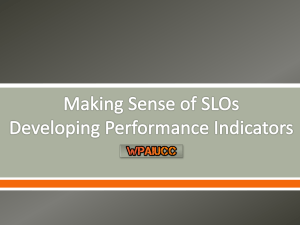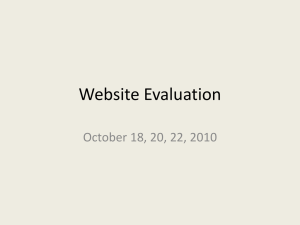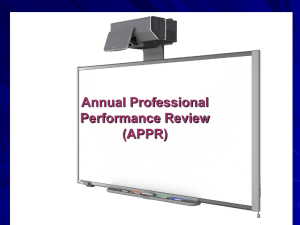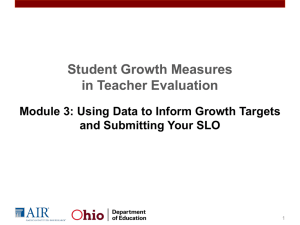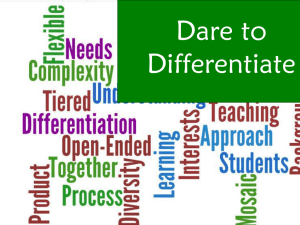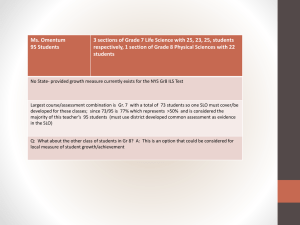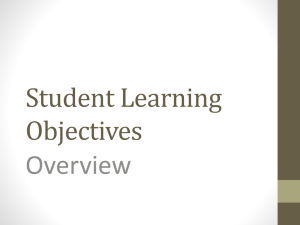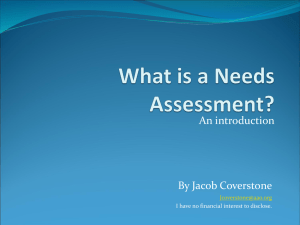Student Learning Objective (SLO) Template
advertisement
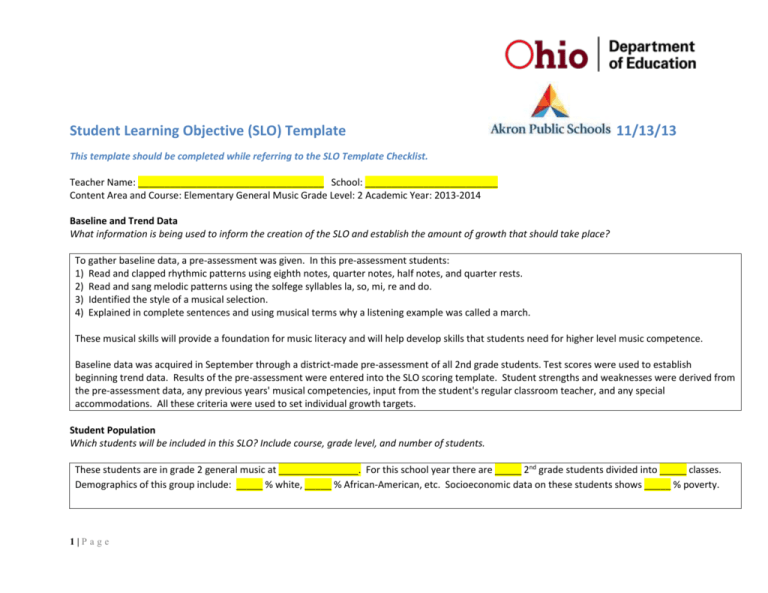
Student Learning Objective (SLO) Template 11/13/13 This template should be completed while referring to the SLO Template Checklist. Teacher Name: ___________________________________ School: _________________________ Content Area and Course: Elementary General Music Grade Level: 2 Academic Year: 2013-2014 Baseline and Trend Data What information is being used to inform the creation of the SLO and establish the amount of growth that should take place? To gather baseline data, a pre-assessment was given. In this pre-assessment students: 1) Read and clapped rhythmic patterns using eighth notes, quarter notes, half notes, and quarter rests. 2) Read and sang melodic patterns using the solfege syllables la, so, mi, re and do. 3) Identified the style of a musical selection. 4) Explained in complete sentences and using musical terms why a listening example was called a march. These musical skills will provide a foundation for music literacy and will help develop skills that students need for higher level music competence. Baseline data was acquired in September through a district-made pre-assessment of all 2nd grade students. Test scores were used to establish beginning trend data. Results of the pre-assessment were entered into the SLO scoring template. Student strengths and weaknesses were derived from the pre-assessment data, any previous years' musical competencies, input from the student's regular classroom teacher, and any special accommodations. All these criteria were used to set individual growth targets. Student Population Which students will be included in this SLO? Include course, grade level, and number of students. These students are in grade 2 general music at _______________. For this school year there are _____ 2nd grade students divided into _____ classes. Demographics of this group include: _____ % white, _____ % African-American, etc. Socioeconomic data on these students shows _____ % poverty. 1|Page _____ students have IEP’s which provide for reading accommodations, extended time, etc. with the additional support of a teacher’s assistant. Those reading accommodations will have a contextual factor of this SLO. _____ students receive services only for speech which will not affect his/her growth performance on this SLO. Modifications were made according to these students’ individual plans. _____ students are considered gifted and talented. The stretch that is a part of both the pre- and post-assessments will make this assessment developmentally appropriate. _____ student was excluded from this SLO due to his inability to use language to communicate with peers and adults. He will be covered under another SLO with his special education teacher. No other students or subgroups were excluded from this SLO. Interval of Instruction What is the duration of the course that the SLO will cover? Include beginning and end dates. Akron Public Schools are in session from August to June. However, the students will be covered under this SLO from September, 2013 to the end of March, 2014. This SLO assumes that classes meet for one period once each week for the entire school year. Classes that meet on Mondays or Fridays generally meet for fewer days during a grading period because of holidays or days off per teacher's contract. Field trips, assemblies, special programs, and calamity days also affect student contact time and therefore student’s growth measures. Pre-assessments were given in September. Instruction will occur throughout the year. Post-assessments will be given by the end of March. Standards and Content What content will the SLO target? To what related standards is the SLO aligned? One of the goals of studying music is to give young musicians skills in music literacy while participating in active music-making. By utilizing the discovery learning process, students stay more engaged and enjoy practicing the skills. For many students the success they attain in music class opens doors of excitement and raises self-esteem. The content standards listed below are a foundational building block for that music literacy. The 2012 Ohio Music Content Standards covered within this 2013 SLO include: 4CE: Identify elements of music using developmentally appropriate vocabulary (e.g. rhythm syllables and solfege). 3PR: Read, write and perform using eighth notes, quarter notes, half notes and quarter rests in 2/4 and 4/4 meter. 5PR: Read, write and perform pentatonic (la-so-mi-re-do) melodies on the treble staff in G-do, F-do, and C-do using a system (e.g. solfege, numbers, or letters). 2|Page 3CE: Listen to and identify music of various styles, composers, periods and cultures. 2RE: Discuss music of various composers, periods, cultures and contrasting styles. 3RE: Discuss how music communicates feelings, moods, images, and meaning. The National Music Standards covered within this SLO include: 1. Singing, alone and with others, a varied repertoire of music. 5. Reading and notating music. 6. Listening to, analyzing, and describing music. Assessment(s) What assessment(s) will be used to measure student growth for this SLO? The assessments consist of four parts: 1) Reading and performing 2-measure randomly chosen rhythms in 2/4 and 4/4(individualized); 2) Reading and performing 3-note randomly chosen solfege melodies (individualized); 3) Listening; and 4) Analysis. Both the pre- and post-assessments consist of written and performance items. Both assessments utilize a variety of questioning/assessment strategies (clapping, singing, using hand signs and vocal syllables, fill-in-the-blank, and written extended response.) Both the pre- and post-assessments are scripted for teachers to insure that the assessments are presented in the same manner across the district. The assessments were written by a team of teachers and were reviewed by the music supervisor. The pre-assessment will be administered at the beginning of the school year (September). Teaching, reviewing, and formative assessments will be done throughout the school year. The postassessments will be administered in the spring (March, 2014). Stretch will be addressed on both the pre- and post-assessments. The rhythm stretch component involves a longer rhythmic pattern consisting of 4 measures. The melody stretch component involves a longer solfege singing pattern consisting of 5 notes. These will challenge the gifted learner and give other learners a lofty goal. Teacher's assessments packets include: Overview page that lists teacher information about administering and scoring the test. FAQ about SLOs/SLO Timeline for Teacher. Administering the Pre-Assessment/ Scoring the Pre-Assessment/ Setting Score Ranges and Growth Targets. Scoring the Post-Assessment and Determining Growth. Teacher Script/ Answer Key. Copy of the SLO Scoring Template (for reference only). A chart of all the rhythmic patterns that will be used in the assessment and that have been color coordinated and copied onto 81/2X 14 flashcards. 3|Page A chart of all the melodic patterns that will be used in the assessment and that have been color coordinated and copied onto 81/2X 14 flashcards. Beginning of the year letter to parents outlining information about the upcoming SLO. End of the year letter to parents offering ideas of ways to utilize the educational opportunities to improve their child's musical literacy. Information on the Listening and Analysis section including correct answers for listening and possible answers for the analysis. Copy of the Pre-assessment scoring page. Testing CD information (all listening excerpts will be burned to one CD for ease of testing.) Copy of the general grade 2 SLO for teachers to personalize before submission to the vetting committee. PRE-ASSESSMENT (Administered in September, 2013): 1) Reading and Performing Rhythms: Using a metronome, the teacher set a tempo of quarter note=80. Using district-developed rhythm flashcards*, each student read and clapped one 2-measure line of rhythm from each of the two meters (2/4 (yellow) and 4/4 (white) while saying the Kodaly rhythm syllables of ta, titi, ta-ah, and silence. The teacher scored the responses using the attached pre-assessment points sheet. STRETCH: Students were given the opportunity to do a longer 4-measure rhythm by combining two of the 4/4 (white) flashcards. The teacher scored the responses using the pre-assessment Rhythm Stretch points sheet. 2) Reading and Performing Melodies: Using district-developed flashcards* of 3-note solfege patterns in the key of C Major, each student read and performed two patterns, one easier card utilizing do-re-mi (yellow) and then one card with harder intervals using mi-so-la (green). Students were expected to sing the solfege syllables and to use Kodaly hand signs. The teacher scored the responses using the pre-assessment points sheet. STRETCH: Students were given the opportunity to sing a 5-note solfege pattern (white). The teacher scored the responses using the pre-assessment Solfege Stretch points sheet. *By using a random mix of flashcards for both the pre-assessment and the post-assessment, the teacher can be assured that students will not hear the same pattern repeatedly before it is their turn. It will also help reduce the chances of a student performing the same patterns on the pre-assessment. 3) Listening: Students listened to C-A-G (on the testing CD and on Spotlight on Music, Grade 1, page T241, CD 11:10) and were to identify the style of music using fill-in-the-blank. The teacher scored the responses using the pre-assessment Listening points sheet. 4) Analysis: Students listened to The Washington Post March (on the testing CD and/or on Spotlight on Music, Grade 2, page 339. CD 17:5) and were instructed to write two musical reasons why this was called a march. The teacher scored the responses using the pre-assessment rubric. Formative Assessments, written, aural, and vocal, will be given between the months of September and March. These assessments will not be scored toward this SLO but will be used to inform instruction and teacher planning. Through the use of these informal assessments, which students may or may 4|Page not know are being administered, students will become comfortable performing alone and with others. Also, the formative assessments can provide a stretch for all abilities through varied difficulty levels, without the pressure of "grading". POST-ASSESSMENT (Administered in March, 2014): The Post-Assessment will contain items similar to but not necessarily exactly the same as the Pre-Assessment. The pre- and post-assessments used to measure student growth for this SLO were created by a district team of elementary music teachers and the music supervisor from the Akron Public Schools. Both assessments consist of written and performance items. The pre and post tests will be slightly different to follow best practice to challenge all learners. A stretch will be offered in both the Pre and Post-Assessments. Students on IEPs who receive support from an aide for reading accommodations will certainly have an impact on the contextual factor of this SLO. Other students on IEPs or those in an Achieve Unit or a NOW unit will have modifications of their growth targets, if necessary, to ensure that they too can show growth that is developmentally appropriate. Combining assessments into a final score: Because the pre-assessment is made up of many sections (Reading and Performing Rhythms, Reading and Performing Melodies, Listening, and Analysis), the final score will be a combination of all four parts. Reading and Performing Rhythms= 9 points Reading and Performing Melodies= 12 points Listening= 5 points Analysis = up to 4 points TOTAL 30 points Growth Target(s) Considering all available data and content requirements, what growth target(s) can students be expected to reach? Student growth will be charted through Performance Plus. Based on pre-assessment scores (which will be collected in September, 2013), tiers and growth targets will be set so that all students may show growth. TIERS & GROWTH TARGETS After pre-assessment scores have been submitted, the district will set the tiers. 5|Page SETTING INDIVIDUAL GROWTH TARGETS: While it is the most desirable to have all students move up to proficient or advanced that is not always possible. It is expected, though, that students should move up at least to the next tier. Expected growth needs to be set using 4 criteria: Knowledge of students’ academic skills Knowledge of students’ musical skills Knowledge of special accommodations such as IEPs, special needs, or personal situations Knowledge of students’ pre-assessment score Here are some examples: Sally Smith scored 20 on the pre-assessment. She usually does pretty well but she was not feeling well the day of the pre-test. I know from her classroom teacher and from my own observation that she is shy and does not like to perform in front of others. Although she might score in the Advanced level, her growth target probably should be set at 25. Jim Thorne scored a 27 on the pre-assessment. He is a very musical student who gets good grades in 2nd grade and in music. He tries his best and will probably do very well in the post-assessment. His growth target could be set at 29. Tom Thomas scored 3 on the pre-assessment. He has an IEP with accommodations for reading so his teacher's assistant will have to read the test to him. I know that he doesn't communicate well when writing so his Listening and Analysis scores will be low but he loves to clap rhythms. His growth target probably should be set at 10. For example: Student Name Sally Smith Jim Thorne Tom Thomas Baseline Score 20 27 3 Growth Target 25 29 10 Final Score Met Growth Target? Rationale for Growth Target(s) What is your rationale for setting the above target(s) for student growth within the interval of instruction? Music teachers’ school and/or course assignments can change year after year. This makes it especially difficult to get to know our students and their situations in order to set proper growth targets. By using four criteria, teachers can be more confident that they have selected developmentally appropriate goals 6|Page TEACHERS-PLEASE CHOOSE 1 OF THE FOLLOWING SECTIONS AND DELETE THE OTHER OR ADAPT FOR YOUR SITUATION #1 Because I have taught most of these students for many years, individual growth targets were set using four criteria: Knowledge of students’ academic skills; Knowledge of students’ musical skills; Special accommodations such as IEPs, 504s, or special needs; Students’ pre-assessment scores. #2 Because I am new to this school, individual growth targets were set using these criteria: Consultation with last year's regular education teacher, Consultation with last year's music teacher, Knowledge of special accommodations such as IEPs, 504s or special needs, Students’ pre-assessment scores. #3 I am not new to this school but I will be teaching most of these students for the first time, so growth targets were set using these criteria: Consultation with last year's regular education teacher, Consultation with last year's music teacher, Knowledge of special accommodations such as IEPs, 504s or special needs, Students’ pre-assessment scores It is the mission of Akron Public Schools to "ensure that each student in our diverse population achieves his or her fullest potential in a safe and affirming learning center characterized by an extensive, student-focused collaboration of all segments of the community, with an emphasis on preparing students to live and excel in a global environment." Students at _______________ come from an urban community that is varied in income levels and in musical opportunities outside of the school day. The majority of our students are low income and have few opportunities for private lessons or concert attendance. Those few students who are 7|Page studying a musical instrument privately should perform at a higher level. Students who score in the less-than-typical range on the pre-assessment will be given guidance and support as needed to ensure all students make at least a year's growth. Both the Ohio Academic Content Standards for music (developed in 2012) and the Akron Public Schools Standards and Benchmarks (developed in 2004) stress the importance of the higher level music skills of producing/ performing and perceiving/knowing/creating. To that end we have chosen this SLO. The mastery of this skill at the middle school level will help ensure a basic knowledge of vocal performance that will enhance and promote middle school and high school musical excellence. Attaining early music goals will set the foundation for beginning musical literacy and pitch accuracy as well as equip students for vocal and instrumental performance in later years. Arts education assists students in becoming well-rounded individuals who contribute to a global society. 8|Page
